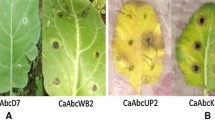Abstract
Verticillium wilt, caused by Verticillium dahliae, is the most serious disease in olive cultivation areas in western Turkey. Two hundred and eight isolates of V. dahliae from olive (Olea europea var. sativa) trees were taken for vegetative compatibility analysis using nitrate non-utilizing (nit) mutants. One isolate did not produce a nit mutant. Nit mutants of 207 isolates were tested against tester strains of internationally known vegetative compatibility groups (VCGs) 1A, 2A, 2B, 3, 4A and 4B, and also paired in many combinations among themselves. One hundred and eighty nine of the isolates (90.9%) were strongly compatible with T9, the tester strain of VCG1A, and thus were assigned to VCG1A. Eight isolates were assigned to VCG2A and four isolates to VCG4B. One isolate was heterokaryon self-incompatible (HSI) and five isolates could not be grouped to any of the VCGs tested. Pathogenicity assays were conducted on a susceptible olive cultivar (O. europea cv. Manzanilla) and a susceptible local cotton cultivar (Gossypium hirsutum cv. Çukurova 1518). Both cotton and olive inoculated with all VCG1A isolates showed defoliating symptoms in greenhouse tests. This is the first report on VCGs in V. dahliae from olive trees in Turkey which demonstrates that VCG1A of the cotton-defoliating type is the most commonly detected form from olive plants in the western part of Turkey.


Similar content being viewed by others
References
Anonymous (2005). FAOSTAT database. http://faostat.fao.org/site/408/default.aspx.
Bao, J. R., Katan, J., Shabi, E., & Katan, T. (1998). Vegetative compatibility groups in Verticillium dahliae from Israel. European Journal of Plant Pathology, 104, 263–269.
Bejarano-Alcázar, J., Melero-Vara, J. M., Blanco-López, M. A., & Jıménez-Díaz, R. M. (1995). Influence of inoculum density of defoliating and non-defoliating pathotypes of Verticillium dahliae on epidemics of Verticillium wilt of cotton in southern Spain. Phytopathology, 85, 1474–1481.
Bell, A. A. (1992). Verticillium wilt. In R. J. Hillocks (Ed.), Cotton diseases (pp. 87–126). Oxford, UK: C.A.B. International.
Bell, A. A. (1994). Mechanisms of disease resistance in Gossypium species and variation in Verticillium dahliae. In G. A. Constable & N. W. Forrester (Eds.), Proceedings of the World Cotton Research Conference-1 (pp. 225–235). Melbourne, Australia: CSIRO.
Bellahcene, M., Fortas, Z., Fernandez, D., & Nicole, M. (2005). Vegetative compatibility of Verticillium dahliae isolates from olive trees (Olea europea L.) in Algeria. African Journal of Biotechnology, 4, 963–967.
Benlioğlu, S., Ulusal, H., Demirbaş, M. (2001). Verticillium wilt in olive trees of Aydın province. Turkish Phytopathology Congress-9 (pp. 307–315). Tekirdağ, Turkey.
Bhat, R. G., Smith, R. F., Koike, S. T., Wu, B. M., & Subbarao, K. V. (2003). Characterization of Verticillium dahliae isolates and wilt epidemics of pepper. Plant Disease, 87, 789–797.
Blanco-López, M. A., Jiménez-Díaz, R. M., & Caballero, J. M. (1984). Symptomatology, incidence and distribution of Verticillium wilt of olive trees in Andalucía. Phytopathologia Mediterranea, 23, 1–8.
Chandelier, A., Laurent, F., Dantinne, D., Mariage, L., Etienne, M., & Cavalier, M. (2003). Genetic and molecular characterization of Verticillium dahliae isolates from woody ornamentals in Belgian nurseries. European Journal of Plant Pathology, 109, 943–952.
Chen, W. (1994). Vegetative compatibility groups of Verticillium dahliae from ornamental woody plants. Phytopathology, 84, 214–219.
Cherrab, M., Bennani, A., Charest, P. M., & Serrhini, M. N. (2002). Pathogenicity and vegetative compatibility of Verticillium dahliae isolates from olive in Morocco. Journal of Phytopathology, 84, 703–709.
Collado-Romero, M., Mercado-Blanco, J., Olivares-García, C., Valverde-Corredor, A., & Jiménez-Díaz, R. M. (2006). Molecular variability within and among Verticillium dahliae vegetative compatibility groups determined by fluorescent amplified fragment length polymorphism and polymerase chain reaction markers. Phytopathology, 96, 485–495.
Correll, J. C., Klittich, C. J. R., & Leslie, J. F. (1987). Nitrate non-utilizing mutants of Fusarium oxysporum and their use in vegetative compatibility tests. Phytopathology, 77, 1640–1646.
Daayf, F., Nicole, M., & Geiger, J. P. (1995). Differentiation of Verticillium dahliae populations on the basis of vegetative compatibility and pathogenicity on cotton. European Journal of Plant Pathology, 101, 69–79.
Dervis, S., & Bicici, M. (2005). Vegetative compatibility groups in Verticillium dahliae isolates from cotton in Turkey. Phytoparasitica, 33, 157–168.
Elena, K., & Paplomatas, E. J. (1998). Vegetative compatibility groups within Verticillium dahliae isolates from different hosts in Greece. Plant Pathology, 47, 635–640.
Jiménez-Díaz, R. M., Tjamos, E. C., & Cirulli, M. (1998). Verticillium wilt of major tree hosts: Olive. In J. A. Hiemstra & D. C. Harris (Eds.), A compendium of Verticillium wilt in trees species (pp. 13–16). Wageningen: Ponsen & Looyen.
Jiménez-Díaz, R. M., Mercado-Blanco, J., Olivares-García, C., Collado-Romero, M., Bejarano-Alcázar, J., Rodríguez-Jurado, D., et al. (2006). Genetic and virulence diversity in Verticillium dahliae populations infecting artichoke in eastern-central Spain. Phytopathology, 96, 288–298.
Joaquim, T. R., & Rowe, R. C. (1991). Vegetative compatibility and virulence of strains of Verticillium dahliae from soil and potato plants. Phytopathology, 81, 552–558.
Katan, T. (2000). Vegetative compatibility in populations of Verticillium – An overview. In E. C. Tjamos, R. C. Rowe, J. B. Heale, & D. R. Fravel (Eds.), Advances in Verticillium, research and disease management (pp. 77–94). St. Paul, Minnesota: APS Press.
Korolev, N., & Katan, T. (1997). Improved medium for selecting nitrate non-utilizing (nit) mutants of Verticillium dahliae. Phytopathology, 87, 1067–1070.
Korolev, N., Katan, J., & Katan, T. (2000). Vegetative compatibility groups of Verticillium dahliae in Israel: Their distribution and association with pathogenicity. Phytopathology, 90, 529–566.
Korolev, N., Pérez-Artés, E., Bejarano-Alcázar, J., Rodríguez-Jurado, D., Katan, J., Katan, T., et al. (2001a). Comparative study of genetic diversity and pathogenicity among populations of Verticillium dahliae from cotton in Spain and Israel. European Journal of Plant Pathology, 107, 443–456.
Korolev, N., Katan, J., & Katan, T. (2001b). Cotton-associated vegetative compatibility groups of Verticillium dahliae in Israel and their pathogenicity. Phytoparasitica, 29, 244 (abstr.).
López-Escudero, F. J., & Blanco-López, M. A. (2001). Effect of a single or double soil solarization to control Verticillium wilt in established olive orchards in Spain. Plant Disease, 85, 489–496.
López-Escudero, F. J., & Blanco-López, M. A. (2005). Recovery of young olive trees from Verticillium dahliae. European Journal of Plant Pathology, 113, 367–375.
López-Escudero, F. J., delRío, C., Caballero, J. M., & Blanco-López, M. A. (2004). Evaluation of olive cultivars for resistance to Verticillium dahliae. European Journal of Plant Pathology, 110, 79–85.
Martos-Moreno, C., López-Escudero, F. J., & Blanco-López, M. A. (2006). Resistance of olive cultivars to the defoliating pathotype of Verticillium dahliae. HortScience, 41, 1313–1316.
Mercado-Blanco, J., Rodríguez-Jurado, D., Pérez-Artés, E., & Jiménez-Díaz, R. M. (2001). Detection of the nondefoliating pathotype of Verticillium dahliae in infected olive plants by nested PCR. Plant Pathology, 50, 609–619.
Mercado-Blanco, J., Rodríguez-Jurado, D., Parrilla-Araujo, S., & Jiménez-Díaz, R. M. (2003). Simultaneous detection of the defoliating and nondefoliating Verticillium dahliae pathotypes in infected olive plants by duplex, nested polymerase chain reaction. Plant Disease, 87, 1487–1494.
Pegg, G. F., & Brady, B. L. (2002). Verticillium wilts. Oxford: CAB International.
Pennisi, A. M., Cacciola, S. O., Magnanodi, S. G., & Perrotta, G. (1993). Evaluation of the susceptibility of olive cultivars to Verticillium wilt. OEPP/EPPO Bulletin, 23, 537–541.
SAS Institute Inc. (1998). SAS/STAT user’s guide, version 6 edition. Cary, NC: SAS Institute Inc.
Saydam, C., & Copcu, M. (1972). Verticillium wilt of olives in Turkey. Journal of Turkish Phytopathology, 9, 235–252.
Schnathorst, W. C., & Sibbett, G. S. (1971). The relation of strain of Verticillium albo-atrum to severity of Verticillium wilt in Gossypium hirsutum and Olea europaea in California. Plant Disease Reporter, 9, 780–782.
Smith, H. C. (1965). The morphology of Verticillium albo-atrum, V. dahliae, and V. tricopus. New Zealand Journal of Agricultural Research, 8, 450–478.
Strausbaugh, C. A. (1993). Assessment of vegetative compatibility and virulence of Verticillium dahliae isolates from Idaho potatoes and tester strains. Phytopathology, 83, 1253–1258.
Tsror, L., & Levin, A. G. (2003). Vegetative compatibility and pathogenicity of Verticillium dahliae Kleb. isolates from olive in Israel. Journal of Phytopathology, 151, 451–455.
Yolageldi, L., Tunç, C., Onoğur, E., & Yıldırım, I. (2001). Batı Anadolu’da zeytin Verticillium solgunluğunun yaygınlığı, yakalanma oranı, hastalık şiddeti ve hastalık çıkışında etkili bazı faktörler üzerinde araştırmalar. IX.th Turkish Phytopathology Congress (pp. 299–305). Tekirdag, Turkey.
Zhengjun, X., Achar, P. N., & Benkang, G. (1998). Vegetative compatibility groupings of Verticillium dahliae from cotton in mainland China. European Journal of Plant Pathology, 104, 871–876.
Acknowledgements
This research was supported by The Scientific and Technical Research Council of Turkey (TUBITAK). We thank Dr. Nadia Korolev for providing the international reference isolates of the V. dahliae VCGs, Dr. F. Evrendilek and Dr. A. E. Yıldırım for critical reading of manuscript. We also thank Sinem Aldemir and Sezgin Kadıoğlu for their technical assistance.
Author information
Authors and Affiliations
Corresponding author
Rights and permissions
About this article
Cite this article
Dervis, S., Erten, L., Soylu, S. et al. Vegetative compatibility groups in Verticillium dahliae isolates from olive in western Turkey. Eur J Plant Pathol 119, 437–447 (2007). https://doi.org/10.1007/s10658-007-9183-z
Received:
Accepted:
Published:
Issue Date:
DOI: https://doi.org/10.1007/s10658-007-9183-z




